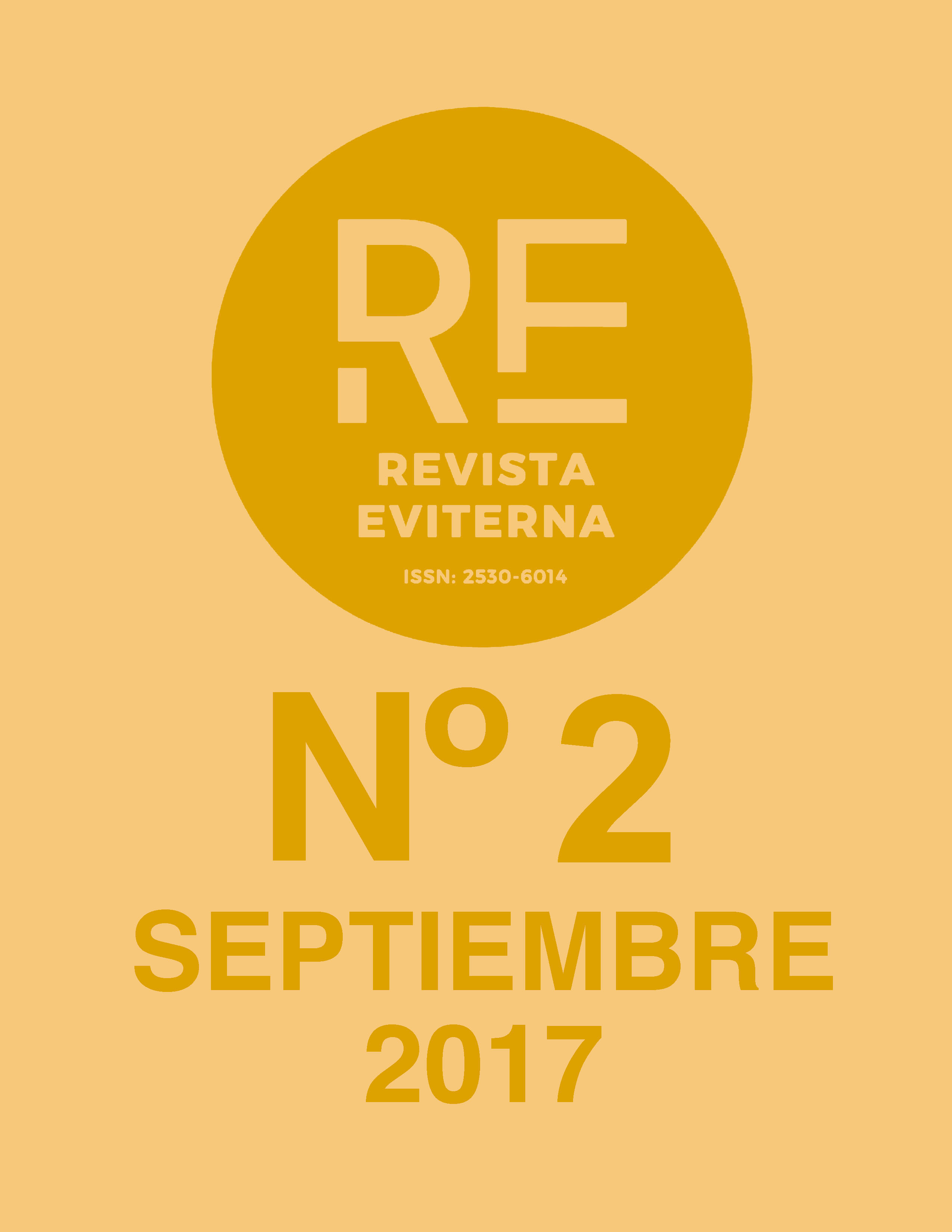Links and parallels between baroque and media culture: the case of Miguel Mañara
DOI:
https://doi.org/10.24310/Eviternare.v0i2.8113Keywords:
Mañara; Baroque; Media Culture; Mass media; Visual cultureAbstract
Such apparently distant cultures as Baroque and the contemporary media world share many nexuses, circumstances and manifestations. Through the archetypical baroque figure of Miguel Mañara, we will justify these parallelisms, based on his artistic and cultural production well into the 17th century, and on his transversal values, bringing Mañara to the present mass media.
Downloads
Metrics
Publication Facts
Reviewer profiles N/A
Author statements
Indexed in
-
—
- Academic society
- N/A
- Publisher
- Universidad de Málaga
References
ARCHIDIÓCESIS DE SEVILLA (2015), Recuperado de: http://www.archisevilla.org/iniciativas-para-el-fomento-de-la-devocion-de-miguel-de-manara/ (Consultado: 29/5/2017)
BROWN, Jonathan (1980), “Jeroglíficos de muerte y salvación: La decoración de la iglesia de la hermandad de la Caridad en Sevilla”, en Imágenes e ideas en la pintura española del siglo XVII. Alianza, Madrid, pp. 179-207.
CARROLL, Nöel, ALCORIZA, Javier, (trad.) (2003). Una filosofía del arte de masas. Machado Libros: Madrid.
CHUST, Manuel, MÍNGUEZ, Víctor, eds.(2003). La construcción del héroe en España y México. Universidad de Valencia:Valencia.
CONSEJERÍA DE CULTURA JUNTA DE ANDALUCÍA (2016), Recuperado de: https://www.youtube.com/watch?v=ijQ-r52W_Og (Consultado: 31/5/17)
CONTRAPRODUCENTES PRODUCCIONES (2016), Recuperado de: https://www.youtube.com/watch?v=A1RQliLrAZ8 (Consultado: 2/6/17)
DIARIO ABC (2015), Recuperado de: http://sevilla.abc.es/sevilla/sevi-profundis-miguel-manara-santa-caridad-201512262151_noticia.html (Cnsultado: 1/5/17)
DOMÍNGUEZ ORTÍZ, Antonio, AGUILAR PIÑAL, Francisco (1976). Historia de Sevilla IV. El barroco y la ilustración. Universidad de Sevilla: Sevilla.
EL PAÍS (2010), Recuperado de: http://elpais.com/diario/2010/04/14/andalucia/1271197336_850215.html (Consultado: 1/6/17)
EUROPAPRESS (2016), Recuperado de: http://www.europapress.es/andalucia/fundacion-cajasol-00621/noticia-exposicion-misericordiae-vultus-catedral-sevilla-renueva-20160603152730.html (Consultado: 30/5/17)
MADE OFFICINA CREATIVA (2012) (a), Recuperado de: https://www.youtube.com/watch?v=V5of_q0Z6AI (Consultado: 1/6/17)
MADE OFFICINA CREATIVA (2012) (b), Recuperado de: https://www.youtube.com/watch?v=DBowOwnot6Y (Consultado: 1/6/17)
FRANCASTEL, Pierre y Galienne (1978), El retrato. Cátedra: Madrid.
FREEDBERG, David (2010). El poder de las imágenes. Cátedra: Madrid.
GUBERN, Román (1974). Mensajes icónicos en la cultura de masas. Edit. Lumen: Barcelona.
GUBERN, Román (1997). Medios icónicos de masas. Historia 16: Madrid.
HAZAÑAS Y LA RÚA, Joaquín (1913), Recuperado de:
https://www.bibliotecadelaserrania.com/download/documentos_pdf/TENORIO-Y-MANARA.pdf (Consultado: 2/6/17)
HERMANDAD DE LA SANTA CARIDAD, Recuperado de: http://www.santa-caridad.es/ (Consultado: 1/6/17)
MARTÍN HERNÁNDEZ, Francisco (1981). Miguel Mañara. Universidad de Sevilla: Sevilla.
MARAVALL, José Antonio (1980). La cultura del barroco. Análisis de una estructura histórica. Edit. Ariel: Barcelona.
NÚÑEZ BELTRÁN, Miguel Ángel (2000). La oratoria sagrada de la época del barroco. Doctrina, cultura y actitud ante la vida desde los sermones sevillanos del siglo XVII. Universidad de Sevilla: Sevilla.
PUELLES ROMERO, Luis (2011). Mirar al que mira. Edit. Abada: Madrid.
RAMÍREZ, Juan Antonio (1981). Medios de masas e Historia del Arte. Edic. Cátedra: Madrid.
RODRÍGUEZ DE LA FLOR, Fernando (1999). La península metafísica. Arte, literatura y pensamiento en la España de la Contrareforma. Biblioteca Nueva: Madrid.
VALDIVIESO, Enrique, SERREA, Juan Miguel (1979). El Hospital de la Caridad de Sevilla. Edit. Sever-Cuesta: Valladolid.
WORDPRESS (2010), Recuperado de: https://framuru2.wordpress.com/2010/04/07/exposicion-miguel-manara-espiritualidad-y-arte-en-el-barroco-sevillano-1627-1679/ (Consultado: 1/6/17)
ZUNZUNEGUI, Santos (1992). Pensar la Imagen. Cátedra/Universidad del País Vasco: Madrid.
Downloads
Published
How to Cite
Issue
Section
License
All the contents published in Revista Eviterna are subject to the Creative Commons Reconocimento-NoComercia-Compartirigual 4.0 license, the full text of which can be found at <http://creativecommons.org/licenses/by-nc-sa/4.0>
They may be copied, used, disseminated, transmitted and publicly exposed, provided that:
The authorship and original source of your publication (Journal, editorial and URL of the work) are cited.
They are not used for commercial purposes.
The existence and specifications of this use license are mentioned.

Copyright is of two kinds: moral rights and patrimonial rights. Moral rights are perpetual, inalienable, inalienable, inalienable, inalienable and imprescriptible prerogatives.
In accordance with copyright legislation, Revista Eviterna recognizes and respects the moral rights of the authors, as well as the ownership of the economic right, which will be transferred to the University of Malaga for dissemination in open access.
The economic rights refer to the benefits obtained by the use or disclosure of the works. Revista Eviterna is published in open access and is exclusively authorized to carry out or authorize by any means the use, distribution, disclosure, reproduction, adaptation, translation or transformation of the work.
It is the responsibility of the authors to obtain the necessary permissions of the images that are subject to copyright.







12.png)



